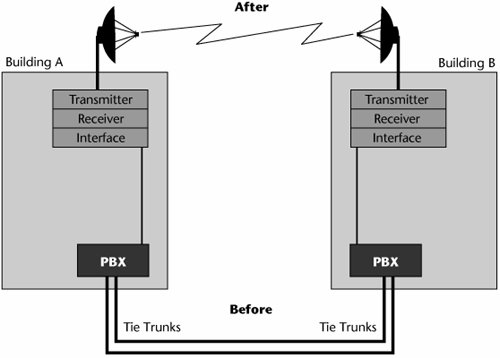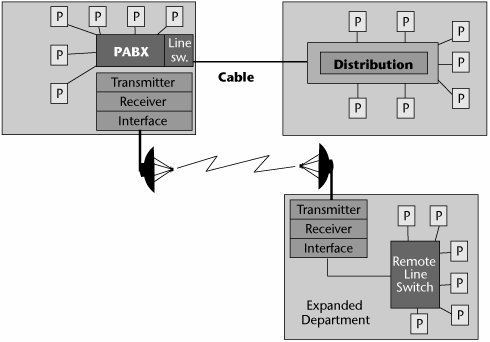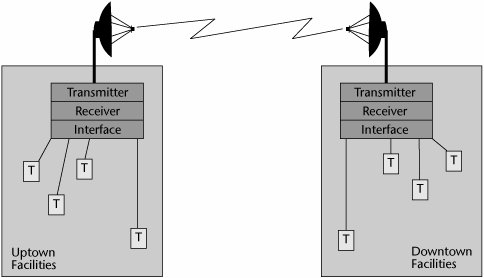Microwave
Microwave was used during World War II in military applications, and when it was successful in that environment, it was introduced into commercial communications. Microwave was deployed in the PSTN as a replacement for coaxial cable in the late 1940s.
As mentioned earlier, twisted-pair and coax both face limitations because of the frequency spectrum and the manner in which they are deployed. But microwave promises to have a much brighter future than twisted-pair or coax. Many locations cannot be cost-effectively cabled by using wires (e.g., the Sahara, the Amazon, places where buildings are on mountaintops, villages separated by valleys), and this is where microwave can shine. In addition, the microwave spectrum is the workhorse of the wireless world: The vast majority of wireless broadband solutions operate in the microwave spectrum.
Note that the discussion of microwave in this chapter focuses on its traditional application in carrier and enterprise private networks, but there are indeed many more systems and applications to discuss, and those are covered at length in Chapter 13, "Wireless Communications Basics," and Chapter 16, "Emerging Wireless Applications." This chapter focuses on the general characteristics of microwave and its use in traditional carrier backbones and enterprise private networks.
Characteristics of Microwave
Microwave is defined as falling in the 1GHz to 100GHz frequency band. But systems today do not operate across this full range of frequencies. In fact, current microwave systems largely operate up to the 50GHz range. At the 60GHz level, we encounter the oxygen layer, where the microwave is absorbed by the surrounding oxygen, and the higher frequencies are severely affected by fog. However, we are now producing systems called virtual fiber that operate in the 70GHz to 95GHz range at very short distances. Given the growing demand for wireless access to all forms of media, we can expect to see many developments in coming years that take advantage of the high-bandwidth properties of the higher frequency bands.
The amount of bandwidth that you can realize out of the very large microwave spectrum is often limited by regulations as much as by technology. Before you can deploy a microwave system outside your own private campus, you have to be licensed to operate that system in all environments. In your own private territory, you can use unlicensed bands, but if you want to cross the public domain using licensed spectrum, you must first be granted approval by your spectrum management agency to operate within a given frequency allocation.
Some communities are very concerned about the potential health hazards of microwave and create legislation or council laws that prohibit placement of such systems. In addition, some communities are very sensitive to the unsightliness of towers and argue that the value of real estate will drop if they are constructed. Therefore, several companies specialize in building camouflaged towers. When you see a tall tree, a church steeple, a light post, or a chimney, it could be a wireless tower disguised to protect your aesthetic balance.
Microwave is generally allocated in chunks of 30MHz to 45MHz channels, so it makes available a substantial amount of bandwidth to end users and operators of telecommunications networks.
Microwave is subject to the uncertainties of the physical environment. Metals in the area, precipitation, fog, rainfall, and a number of other factors can cause reflections and therefore degradations and echoes. The higher (in elevation) we move away from land-based systems, the better the performance because there is less intrusion from other land-based systems, such as television, radio, and police and military systems.
Repeater spacing with microwave varies depending on the frequency of transmission. Remember from Chapter 1 that lower frequencies can travel farther than higher frequencies before they attenuate. Higher frequencies lose power more rapidly. In microwave systems that operate in the 2GHz, 4GHz, and 6GHz bands, towers can be separated by 45 miles (72 km). In the higher-frequency allocations, such as 18GHz, 23GHz, and 45GHz, the spacing needs to be much shorter, in the range of 1 to 5 miles (1.6 to 8 km). This is an important issue in network design and, depending on the scope over which you want to deploy these facilities, it can have a significant impact on the investment required.
Another important design criterion is that microwave requires line of sight and is a highly directional beam. Microwave requires a clear, unobstructed view, and it can't move through any obstacles, even things you wouldn't think would be obstacles, such as leaves on a tree. Technologies that depend on line of sight may work brilliantly in areas that have the appropriate terrain and climate, and they may not perform very well where there are many obstacles or where there is a lot of precipitation. Furthermore, line of sight is restricted by the curvature of the earth, which interrupts the line of sight at about 90 miles (144 km). However, new spectrum utilization techniques such as Orthogonal Frequency Division Multiplexing (OFDM) permit non-line-of-sight operation, greatly expanding the use of microwave. (Chapter 15 discusses OFDM in detail.)
The impact of precipitation on microwave can be great. Microwave beams are small, and as you go up into the higher bands, the waveforms get smaller and smaller. Pretty soon, they're smaller than a raindrop, and they can be absorbed by a raindrop and then scattered in a million directions. Therefore, in wet atmospheric conditions, there is a great potential for problems with microwave. As a result, practicing network diversityusing both terrestrial and nonterrestrial alternativesis critical.
Traditional Applications of Microwave
One application associated with microwave is to replace the use of leased lines in a private network. Figure 2.3 shows a simple voice environment that initially made use of dedicated leased lines, also known as tie trunks, to link two PBXs in two different buildings across town from one another. Because these tie trunks were billed on a monthly basis and were mileage sensitive, they were going to be a cost factor forever. Therefore, a digital microwave system was purchased to replace the tie trunks. This system provides capacity between the buildings and does away with the monthly cost of the leased lines. This setup is commonly used by multinode or multilocation customers (e.g., a health care facility with clinics and hospitals scattered throughout a state or territory, a university with multiple campuses, a retail location with multiple branches, a bank with multiple branches).
Figure 2.3. Connecting PBXs by using microwave

Another key application of microwave is bypassing, which can be interpreted in multiple ways. Initially, this technique was used to bypass the local telecommunications company. With the introduction of competition in the long-distance marketplace, end users in the United States initially had choices about who would be their primary long-distance carrier (i.e., interexchange carrier). But to get to that carrier to transport the long-distance portion of the call, we still needed to get special local access trunks that led through the local operator to the competing interexchange provider. That meant paying an additional monthly fee for these local access trunks. In an attempt to avoid those additional costs, businesses began to bypass the local telephone company by simply putting up a digital microwave systema microwave tower with a shot directly to the interexchange carrier's point of presence.
Bypassing can also be used to circumvent construction. Say that a pharmaceutical company on a large campus has a public thoroughfare, and across the street there's a lovely park where the employees take their lunch and otherwise relax during the day. No one foresaw the fame and fortune the company would achieve with its latest migraine medicine, so it had not planned to build another facility to house the 300 people it now needed to add. Nobody ever provisioned conduit leading to that park across the street. The cost and time to get permission to break ground, lay conduit, pull cable, repave, and relandscape would be cost- and time-prohibitive. To bypass that entire operation, microwave could be used between the main campus and the remote park (see Figure 2.4). This is essentially the same strategy that wireless local loop is pursuing. Rather than take the time and money to build a wireline facility, you can do it much more rapidly and much more cost-effectively on a wireless basis.
Figure 2.4. A bypassing construction that uses microwave

Whereas provisioning twisted-pair or coaxial cable costs roughly US$1,000 to US$1,500 per subscriber and requires a 12- to 18-month deployment time, wireless costs US$300 to US$800 per subscriber and requires 3 to 6 months of deployment time. Something could always delay the process (e.g., contractual problems with the building developer), but, generally, you can deploy a microwave system much more rapidly and at a much lower price point. Therefore, these systems are especially popular in parts of the world where there is not already a local loop infrastructure. In addition, there are several unlicensed bands in the microwave spectrum, which means anyone can use them without needing to apply for and receive a license from the spectrum management agency. This includes the popular 2.4GHz and 5GHz bands used for Wi-Fi, the popular wireless LAN (WLAN) technology used in thousands of "hot spots" around the globe. This makes it even easier for a service provider or an entrepreneur to quickly deploy a wireless network to serve constituents.
Another application for microwave is in the data realm. Say that in your company, the buildings that have telephone systems today are going to have LANs as well, and you want to unite the disparate LANs to create a virtual whole. You can use microwave technology as a bridge between two different LANs, to give the combined network the appearance of being one LAN (see Figure 2.5).
Figure 2.5. A LAN interconnect using microwave

The main factor that inhibits or potentially slows the growth of microwave is that only so many people can be operating on the same frequencies in the same area. Therefore, a big limitation of microwave is potential congestion in key metropolitan areas.
Microwave has a disaster-recovery application as well. Because microwave is relatively inexpensive and quick to deploy, it is a good candidate for use after a disaster damages wireline media, systems, or structures.
Advantages and Disadvantages of Microwave
The advantages of microwave are as follows:
- Cost savings Using microwave is less expensive than using leased lines.
- Portability and reconfiguration flexibility You can pick up a microwave transceiver and carry it to a new building. You can't do that with cables.
- Substantial bandwidth A substantial amount of microwave bandwidth is allocated, so high-speed data, video, and multimedia can be supported.
The main disadvantages of microwave are as follows:
- Line-of-sight requirement You need to ensure that there are no obstacles between towers.
- Susceptibility to environmentally caused distortions Because the environment (e.g., heavy rainstorms) can cause distortion, you need to have backups.
- Regulatory licensing requirement The requirement for regulatory licensing means that you must have time and flexibility to deal with the spectrum agency.
- Potential environmental restrictions Some communities do not allow microwave towers or require that they be camouflaged.
The New Era of Microwave: Wireless Broadband
As mentioned earlier, the initial application of microwave was focused on the replacement of twisted-pair and coaxial cables used in the PSTN. In fact, MCI first utilized microwave to provide voice and data service, introducing the first major competitive action against AT&T, which until 1984 had a monopoly on local and long-distance telephone service in the United States. The 1984 divestiture ruling formally sanctioned competition in the long-distance arena. Microwave offered great cost efficiencies because no cables had to be laid, allowing a new entrant to easily build a network of long-haul trunks to serve busy routes.
The role of microwave has been greatly expanded since the 1980s, with applications in just about every network domain. It is beyond the scope of this discussion of basic characteristics to go into detail on all the options available today, but detailed coverage is provided in Part IV. The following is a summary of the wireless systems that rely on microwave:
- Wireless wide area networks (WWANs) In the context of WWANs, microwave is used to support 2G cellular PCS services (TDMA, GSM, CDMA), 2.5G enhanced data services (GPRS, HSCSD, EDGE), 3G high-speed data and multimedia services (W-CDMA, UMTS, CDMA2000, TD-SCDMA), 3.5G IP backbones (HSDPA, HSUPA, HSOPA), and 4G mobile broadband systems (using OFDM and MIMO technologies). WWANs are discussed further in Chapter 14, "Wireless WANs."
- Wireless metropolitan area networks (WMANs) When it comes to WMANs, the microwave spectrum is used in support of broadband fixed wireless access (BFWA) systems, IEEE 802.16 WiMax standards, the Korean WiBro specification, ETSI's broadband radio access network (BRAN), HiperMAN and HiperAccess, Flash-OFDM, IEEE 802.20 Mobile-Fi, iBurst Personal Broadband System, IEEE 802.22 Wi-TV standards, and virtual fiber or millimeter wave technology. WMANs are discussed further in Chapter 15.
- Wireless local area networks (WLANs) The ever-so-popular WLANs, including the IEEE 802.11 family of protocols and ETSI HiperLAN and HiperLan2, operate in the microwave band, relying on the unlicensed bands of 2.4GHz and 5GHz. WLANs are discussed further in Chapter 15.
- Wireless personal area networks (WPANs) WPAN standards make use of unlicensed portions of the microwave spectrum, including IEEE 802.15.1 Bluetooth, IEEE 802.15.3 WiMedia, Ultra-Wideband (UWB), IEEE 802.15.4 ZigBee, and some applications of RFID. WPANs are discussed further in Chapter 15.
As you can see, microwave is truly the workhorse of the wireless world. Part IV of this book therefore dedicates much attention to its variations.
Part I: Communications Fundamentals
Telecommunications Technology Fundamentals
- Telecommunications Technology Fundamentals
- Transmission Lines
- Types of Network Connections
- The Electromagnetic Spectrum and Bandwidth
- Analog and Digital Transmission
- Multiplexing
- Political and Regulatory Forces in Telecommunications
Traditional Transmission Media
Establishing Communications Channels
- Establishing Communications Channels
- Establishing Connections: Networking Modes and Switching Modes
- The PSTN Versus the Internet
The PSTN
- The PSTN
- The PSTN Infrastructure
- The Transport Network Infrastructure
- Signaling Systems
- Intelligent Networks
- SS7 and Next-Generation Networks
Part II: Data Networking and the Internet
Data Communications Basics
- Data Communications Basics
- The Evolution of Data Communications
- Data Flow
- The OSI Reference Model and the TCP/IP Reference Model
Local Area Networking
Wide Area Networking
The Internet and IP Infrastructures
- The Internet and IP Infrastructures
- Internet Basics
- Internet Addressing and Address Resolution
- The Organization of the Internet
- IP QoS
- Whats Next on the Internet
Part III: The New Generation of Networks
IP Services
Next-Generation Networks
- Next-Generation Networks
- The Broadband Evolution
- Multimedia Networking Requirements
- The Broadband Infrastructure
- Next-Generation Networks and Convergence
- The Next-Generation Network Infrastructure
Optical Networking
- Optical Networking
- Optical Networking Today and Tomorrow
- End-to-End Optical Networking
- The Optical Edge
- The Optical Core: Overlay Versus Peer-to-Peer Networking Models
- The IP+Optical Control Plane
- The Migration to Optical Networking
Broadband Access Alternatives
- Broadband Access Alternatives
- Drivers of Broadband Access
- DSL Technology
- Cable TV Networks
- Fiber Solutions
- Wireless Broadband
- Broadband PLT
- HANs
Part IV: Wireless Communications
Wireless Communications Basics
- Wireless Communications Basics
- A Brief History of Wireless Telecommunications
- Wireless Communications Regulations Issues
- Wireless Impairments
- Antennas
- Wireless Bandwidth
- Wireless Signal Modulation
- Spectrum Utilization
Wireless WANs
- Wireless WANs
- 1G: Analog Transmission
- 2G: Digital Cellular Radio
- 5G: Enhanced Data Services
- 3G: Moving Toward Broadband Wireless
- Beyond 3G
- 4G: Wireless Broadband
- 5G: Intelligent Technologies
WMANs, WLANs, and WPANs
Emerging Wireless Applications
- Emerging Wireless Applications
- The Handset Revolution
- Mobile IP
- The IP Multimedia Subsystem
- Mobile Gaming
- Mobile Video
- Mobile TV
- Mobile Content
Glossary
EAN: 2147483647
Pages: 160
